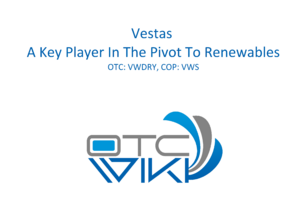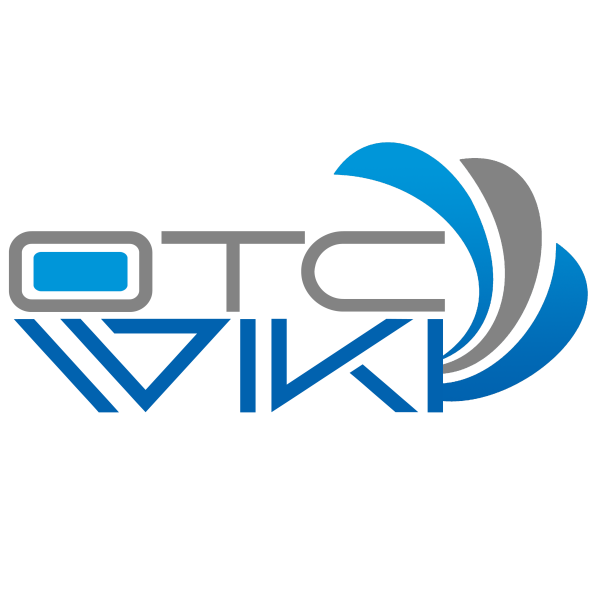Vestas – A Key Player In The Pivot To Renewables
INTEREST OWNERSHIP. Staff of this website may have investments in the featured company and no duty to notify the market when they will be selling or buying more. Conduct your own extensive due diligence and seek the advice of your financial advisor or a registered broker-dealer before investing in anything.
NOT AN INVESTMENT ADVISOR. OTC WIKI, LLC is not licensed by any governing body to give investing advice or provide investment recommendation.
NO RECOMMENDATIONS OR OFFERINGS. Nothing in this article should be construed as, and may not be used in connection with, an offer to sell, or a solicitation of an offer to buy or hold, an interest in any security or investment product. We do not offer any investment products to the general public.
FORWARD-LOOKING STATEMENTS. This article and website contain certain statements, estimates and projections that are "forward-looking statements." All statements other than statements of historical fact on this website are forward-looking statements and include statements and assumptions relating to: plans and objectives of management for future operations or economic performance; conclusions and projections about current and future economic and political trends and conditions; and projected financial results and results of operations. OTC WIKI, LLC does not make any guarantees, representations or warranties (express or implied) about the accuracy of such forward-looking statements. Forward-looking statements involve certain risks, uncertainties, and assumptions and other factors that are difficult to predict. Readers are cautioned that actual results of the investments referenced in this website could differ materially from forward-looking statements; and readers of this website are cautioned not to view forward-looking statements as actual results or place undue reliance on forward-looking statements.
PERFORMANCE RISKS. Past performance is not indicative nor a guarantee of future results. No content on this website shall be viewed as a guarantee of future performance. Investing is inherently risky. Don't trade with money you can't afford to lose.

Vestas Wind Systems A/S (Ticker: VWDRY) is a wind only European company with headquarters in Aarhus, Denmark founded in 1945. Their capabilities are industry leading, in production and servicing of onshore, land located wind turbines, and offshore, ocean located wind turbines. Both of these types of placements for wind are crucial to building an electricity grid in the U.S. for completely sustainable electricity generation. Their siting is specific, so not all areas are ideal for wind turbines.
Currently responsible for more than 145 Gigawatts of electricity from turbines in 85 countries, in addition to 1.5 billion Tons of CO2 not being emitted, Vestas is already having a positive impact on Climate and contribution to sustainable electricity production[1]. The company has deployed more wind power than any other company in the world as of 2019[2] and has manufacturing facilities in throughout Europe, Taiwan, India, United Kingdom, Australia, China, Brazil, and the United States, employing more than 25,000 individuals world-wide.

Vestas currently stands at a $30 Billion USD market cap, which many consider undervalued relative to its market position in the U.S. and the global community. Its business model should thrive in a sustainable focused environment for electricity production. Total revenue for the year ending 12/31/2020 was $14.8 billion, with EPS of $0.78.
The recent explosion of the electric vehicle market has attracted investors attention, as evidence by Tesla Motors expanding from a $3 Billion USD market capitalization in January 2012 to its current $1.15 Trillion USD market capitalization in January 2022. [3] As focus pivots from electric vehicles to renewable energy and large-scale grid storage, Vestas will be a clear beneficiary given its leadership on addressing climate concerns and its wind turbine production and servicing business model.
Vestas is led by President and CEO Henrik Andersen, who has executive experience as a CFO, COO and CEO prior to joining Vestas in 2019. Marika Fredriksson (EVP) has over 20 years of experience in SVP, CFO and EVP roles.
In regards to Vestas Wind Systems’ US based operation, their US headquarters is in Portland Oregon, operating under the name Steelhead Americas. In addition, the company has two factories in Colorado and an office in Boston Massachusetts. The company has installed 40,000 MW domestically and holds servicing contracts for 36,000 MW of installed wind capacity. Vestas currently employs more than 7,000 individuals in the United States.
The wind industry relies on Government permitting and private land permitting to obtain sites where wind turbines can be placed to produce electricity for the grid. Steelhead Americas handles this aspect of the business in the United States.
The major question, when it comes to the US market for wind, is who will dominate the space? The U.S. Department of Energy is working with a few major players in the US wind market. A DOE Memorandum of Understanding was signed with GE Energy, Siemens Power Generation, Vestas Wind Systems, Clipper Windpower, Suzlon Energy and Gamesa Corporation. The Memorandum was set up to provide collaboration and facilitate the exchange of information regarding R&D, operability, siting strategies, standards development and universal interconnection of wind turbines, manufacturing advances in design, process automation and fabrication techniques.
The Department of Energy has a benchmark goal set at achieving a 20% contribution of wind electricity production in the United States by 2030. Currently, only 8.4% of US electricity generation comes from wind[4], signaling a significant growth opportunity for wind production players.
In 2014, the percentage of the US wind market was broken down as follows: GE 60%, Siemens 26%, Vestas 12%. As this was some time ago, things have developed in the years following. According to a DOE report, Land-Based Wind Market Report 2021 Edition, GE supplied 53%, Vestas supplied 34%, Siemens supplied 9%, Nordex 3%, and Goldwind 1%. While General Electric remains the leader in the US wind market for deployment, Vestas has significantly increased their market share of the United States’ wind generation capacity[5].
Considering that GE remains the current dominant player in the wind space inside the United States with mostly onshore land-based turbines, they are a large conglomerate focused on many other. Therefore, GE’s growth generated from its wind production business may be less visible than a pure play wind player such as Vestas.
Not only can Vestas compete against GE in the US market for land siting, it holds a leg up relative to General Electric in regards to offshore, ocean-based wind sites. Should new wind sites move offshore, this will play into the strengths of Vestas as they have full capability and a history of deploying offshore turbines, where their competitors have much less experience.
With all of these fundamental factors affecting Vestas Wind System’s current price, expansion of the EV market, US Government cooperation with Wind turbine manufacturers and servicers, ambitious wind energy goals for the country, offshore wind development only at the very beginning of its journey in the US, and a generally sound balance sheet, cash flow statement and income statement, the stock remains depressed with the recent sell off in clean energy related companies.
- ↑ https://www.vestas.com/en/about/this-is-vestas/who-we-are
- ↑ https://about.bnef.com/blog/vestas-still-rules-turbine-market-but-challengers-are-closing-in/
- ↑ https://companiesmarketcap.com/tesla/marketcap
- ↑ https://www.eia.gov/tools/faqs/faq.php?id=427&t=3
- ↑ Land-Based Wind Market Report: 2021 Edition
